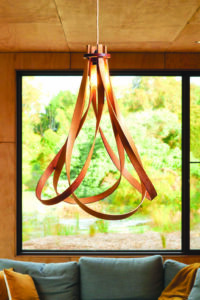Steaming in with bright designs

Hannah and Vaughan McGillivery with the dinghy they built - a reminder of Vaughan's shipwright days.
After nearly two decades crafting ships, Vaughan McGillivery has turned his talents towards brighter pursuits.
Operating from his home workshop in Moolap, McGillivery has founded Timber Technik, which produces lighting pieces inspired by the shapes of the sea and the vessels that inhabit them.
The lighting pieces are created through the use of steam bending techniques, a common practice in boat building.
McGillivery started his career at the age of 16 as an shipbuilder, learning the craft in a four-year apprenticeship in Sorrento under long-time boat builder Tim Phillips and his business The Wooden Boatshop.

As a fully qualified shipwright and builder of luxury yachts for more than 18 years, McGillivery’s work included living and working in the United Kingdom for six years.
“Moving back to Australia and bringing a family up here, we wanted to keep using those boat-building skills but also something we could do from home,” he said.
He said creating lights instead of boats seemed a natural fit for his skills.
“We wanted to create a small-ish product that we could produce at home, at a small scale, and using steam bending – it’s something you do in boat building a lot, and it’s unique in furniture and lighting design, so we were looking for the niche in the market; something that was a bit different.”

Simply put, steam bending is heating timber with steam to the point that it becomes flexible, and shaping it as required using jigs, then letting the timber cool down.
“So there’s no tension in the timber once it’s cool. With all these shapes, that’s how the timber is; it doesn’t go back,” McGillivery said.
“Timber is very impenetrable except with water – but timber cells, once you get them hot enough, become flexible.
“It’s a lot about the preparation. It can be quite involved, creating a jig to bend it around can be quite complex; it all depends on what you need.”

His first design was the “Ocean drop” pendant light.
Made to hang from a ceiling or to be fixed on a wall, the smooth, steam-bent curves subtly imitate a falling drop of water and have the beauty of a simple yet refined design.
Timber Technik has since expanded to several similarly maritime-influenced lighting designs – which can be made to order in various sizes – as well as furniture.
“It’s typical that people put them in a stairwell – they’re decorative lights, they’re more about making a statement and being a feature in the home,” McGillivery said.

The business uses mostly reclaimed timber, from salvage sites or from demolitions.
“It has to be a certain quality for steam bending, so we’re just looking for something interesting or a bit different,” McGillivery said.
“We’ve used timber from the old Geelong whisky distillery recently; we bought Kauri pine timber from there.
From 1920 to 1980 it was the biggest distillery in the Southern Hemisphere, apparently.
“With reclaimed timber, there’s always a history and a story behind it, and the story is a talking point for the light.

“We’ve got a new timber supplier in the Otways, and he’s got a licence for harvesting fallen logs, so that’s cool as well.
“And we use Hydrowood from Tasmania, which is a salvage timber – all the really nice Tassie timber is salvaged from the bottom of lakes, so there’s no forestry footprint.”
He said the past three years of the COVID-19 pandemic had not hit the business particularly hard, and even allowed him to keep his hand in by returning to his shipwright days.
“We actually had a bit more time to do some more developing, and we built a dinghy, but it didn’t affect us too much.

We’re still launching this, and we’d like to see it grow.”
He hoped Timber Technik’s products would make the art of steam bending more accessible and available to the wider market.
“It’s one thing to have a boat, but not everybody has a boat, or wants a boat, or uses a boat, but if you can use some of that craftsmanship in a house, that’s pretty cool.”
For more information on Timber Technik, head to timbertechnik.com
// Sponsored Content

















